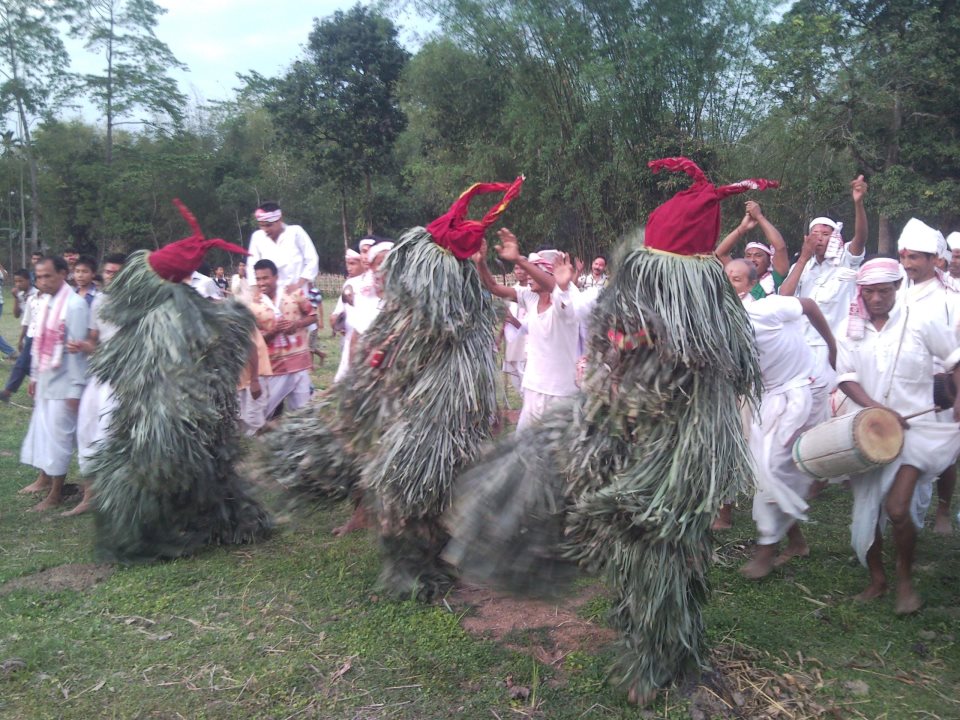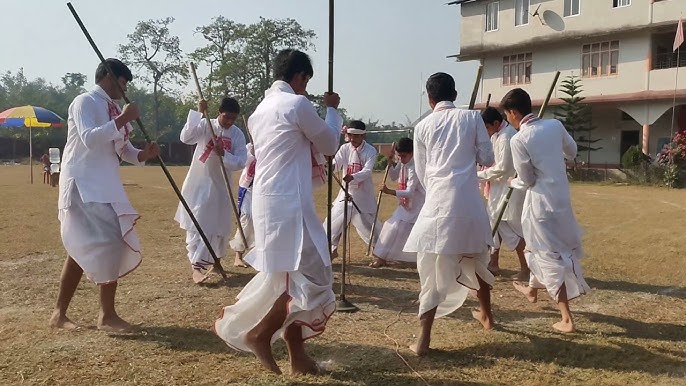
Mohoho is a traditional folk festival celebrated in the lower Assam region of India. This cultural celebration is most prominent in the districts of Kamrup, Goalpara, Barpeta, Nalbari, and Darrang. The festival is celebrated during the month of Agrahayana or Aghun, which falls between November and December according to the modern Gregorian calendar. The most notable feature of this festival is that it takes place on the night of the full moon, bringing the community together for a night of celebration, music, and dance.
In this article, we will explore the origins, customs, and significance of the Mohoho festival, shedding light on its cultural importance in the region.
Etymology of Mohoho
The name “Mohoho” is derived from two distinct linguistic elements—Assamese and Bodo. The Assamese word “moh” translates to “mosquito,” while the Bodo word “ho” means “to drive away.” Together, these terms form the name “Mohoho,” which essentially means “to drive away mosquitoes.” This name aptly captures the essence of the festival, which is centered around driving away pests, especially mosquitoes, that are abundant in the region during the full moon of Agrahayana.
While the primary focus of the festival is to drive away insects, it also represents a time to purify the environment, renew community bonds, and express gratitude for the harvest. It highlights the connection between humans and nature, showing how ancient traditions were designed to deal with both practical and spiritual aspects of life.
Celebrating Mohoho: Rituals and Practices
Mohoho is celebrated with great enthusiasm in Assam, and the observances of this festival are as vibrant as they are meaningful. The festival typically begins in the evening when the community gathers in the village square, the heart of social activity in rural Assam. The main event revolves around the creation of bamboo effigies of mosquitoes, which symbolize the pests that have plagued the region throughout the year.
Traditional Dances and Songs
One of the most cherished elements of Mohoho is the traditional dances and songs that fill the air on the festival night. Men and women from all walks of life come together to perform these dances, which are typically folk dances that have been passed down through generations. These dances are characterized by rhythmic movements, often involving hand gestures and footwork that mimic the act of swatting away mosquitoes. The songs, likewise, are rooted in the community’s agricultural lifestyle, celebrating the harvest and the bond between people.
The most popular song sung during Mohoho captures the essence of the festival’s purpose—driving away mosquitoes. The lyrics are playful and vivid, highlighting the act of chasing away the pests that swarm during the harvest season.
The Bamboo Effigy Burning Ritual
The highlight of the Mohoho festival is the ritual of creating and burning bamboo effigies. Villagers craft intricate effigies of mosquitoes using bamboo, and these figures are placed in a central location, typically near a bonfire. The burning of the effigies symbolizes the purification of the environment, ridding it of unwanted pests. It is a communal act that brings people together, emphasizing unity and shared purpose.
The act of burning the bamboo effigies is not just a practical measure to reduce mosquito presence but also carries a spiritual significance. It is seen as a way to rid the community of negativity, pests, and other harmful elements, thus ensuring a prosperous and healthy year ahead.
The Spiritual and Cultural Significance of Mohoho
Mohoho is more than just a festival; it is a deep-rooted cultural event that reflects the agricultural lifestyle of the Assamese people. The timing of the festival aligns with the end of the harvest season, making it a time for celebration and gratitude. It also serves as a reminder of the interconnectedness of human life and nature. In the past, people faced numerous challenges related to pests, especially mosquitoes, during this time of year. Mohoho was, and still is, a way to confront these challenges in a communal manner.
The festival also has a spiritual aspect, as it is believed to purify the land and the people. The rituals help to renew the village, clearing it of bad luck and pestilence, and preparing the people for the year ahead. This purification process is not just limited to the physical world but extends to the spiritual realm, ensuring that the coming months will bring peace, prosperity, and good health.
The Role of Mohoho in Community Bondin
One of the most important aspects of Mohoho is its role in fostering community bonds. In rural Assam, where farming is the primary occupation, people work together to cultivate the land, and Mohoho is a time to celebrate the fruits of their labor. The festival encourages social cohesion, as it involves everyone, from the youngest children to the eldest members of the community.
The rituals, dances, and songs are communal activities that strengthen relationships among villagers. They create a sense of unity and shared identity, where the people come together to celebrate not just the harvest, but also their collective strength in overcoming the challenges posed by nature. The festival serves as a reminder that no individual can face the challenges of life alone; it is only through cooperation and solidarity that they can thrive.
The Lyrics of Mohoho
The lyrics of the songs sung during Mohoho are filled with humor and imagery, capturing the essence of the festival. Here is an excerpt of one such song:
Lyrics: অ’হৰি মহোহো।
মহ খেদবা টাকান লৌ॥
মহে বোলে মল্লু দে।
টেপল পুৰা খালু দে॥
টেপলত নহ’ল নুন।
চাউল লাগে দুণ দুণ॥
বাঁহৰ পাত চিকিমিকি।
আমাক নাংগে আধলি-সিকি॥
বাঁহৰ পাত পকা।
আমাক লাগে টকা॥
অ’ হৰি অ’ ৰাম
These lyrics are a playful reflection of the festival’s spirit. They talk about the significance of bamboo leaves, rice, and other elements of rural life, while also describing the actions of chasing away pests. The song is both a form of entertainment and a tool for educating younger generations about the traditions of Mohoho.
Conclusion: Mohoho and its Lasting Legacy
Mohoho remains a vibrant celebration of Assam’s rich cultural heritage. While the practical purpose of driving away mosquitoes and pests may seem quaint, the underlying themes of unity, gratitude, and spiritual renewal are timeless. It is a reminder of the importance of community in maintaining harmony with nature, and it continues to be a source of joy and togetherness for the people of lower Assam.
As Assam continues to evolve, festivals like Mohoho serve as a bridge between the past and the present, helping to preserve the traditions that have shaped the identity of the region. By celebrating the harvest, warding off pests, and renewing communal bonds, Mohoho remains a vital part of Assam’s cultural tapestry.
FAQ’s
Q. What is Mohoho?
Mohoho is a traditional folk festival celebrated in the lower Assam region, particularly in districts like Kamrup, Goalpara, Barpeta, Nalbari, and Darrang. It is held during the full moon night of the month of Agrahayana or Aghun, typically around November–December.
Q. Why is Mohoho celebrated?
Mohoho is celebrated to drive away mosquitoes and other pests that are common during this time of the year. It is also a festival to celebrate the harvest and promote community bonding.
Q. What is the meaning of the word “Mohoho”?
The name “Mohoho” is derived from the Assamese word “moh” (meaning mosquito) and the Bodo word “ho” (meaning to drive away). Together, it refers to the act of driving away mosquitoes.
Q. When is Mohoho celebrated?
Mohoho is celebrated during the full moon night of the Assamese month of Agrahayana (Aghun), which corresponds to November or December in the Gregorian calendar.
Q. What are the main rituals of Mohoho?
The main rituals include gathering in village squares for traditional dances and songs, creating bamboo effigies of mosquitoes, and burning them to symbolize the driving away of pests.












